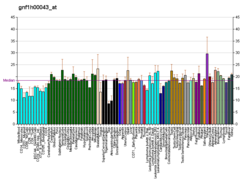Dynein axonemal heavy chain 11 (DNAH11) is a protein that is encoded by the DNAH11 gene in humans. [5] [6] In mice, the protein is encoded by the Dnahc11 gene, the murine homolog to human DNAH11. [7] The protein was previously known as 'left-right' dynein (with the corresponding gene alias lrd) in mice and is particularly notable during embryogenesis for orientation of the eventual body plan. [8] [9]




